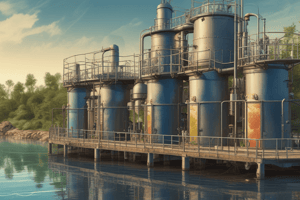Podcast
Questions and Answers
What is the primary advantage of removing hardness from water?
What is the primary advantage of removing hardness from water?
- To reduce the quantity of minerals in water
- To prevent corrosion in pipelines (correct)
- To eliminate pathogenic bacteria
- To reduce the amount of coagulants required
What is the disadvantage of the zeolite process in water treatment?
What is the disadvantage of the zeolite process in water treatment?
- It is a costly process
- It requires a large amount of coagulants
- The softened water is not completely free from hardness (correct)
- It is not effective in removing pathogenic bacteria
What is the primary function of cation exchange resins in the ion exchange process?
What is the primary function of cation exchange resins in the ion exchange process?
- To exchange H+ ions with other cations (correct)
- To exchange OH− ions with other anions
- To add minerals to water
- To remove pathogenic bacteria from water
What is the advantage of the ion exchange process over the lime-soda process?
What is the advantage of the ion exchange process over the lime-soda process?
What is the primary difference between cation and anion exchange resins?
What is the primary difference between cation and anion exchange resins?
What is the purpose of the zeolite process in water treatment?
What is the purpose of the zeolite process in water treatment?
What is the disadvantage of the lime-soda process in water treatment?
What is the disadvantage of the lime-soda process in water treatment?
What is the primary function of anion exchange resins in the ion exchange process?
What is the primary function of anion exchange resins in the ion exchange process?
What is the advantage of the zeolite process over the ion exchange process?
What is the advantage of the zeolite process over the ion exchange process?
What is the primary purpose of water treatment?
What is the primary purpose of water treatment?
Flashcards are hidden until you start studying
Study Notes
Lime-Soda Process
- The lime-soda process converts soluble hardness-causing salts into insoluble precipitates through the addition of soda (Na2CO3) and lime [Ca(OH)2].
- Key hardness issues addressed include temporary hardness, permanent magnesium hardness, dissolved iron, aluminum salts, and gases like CO2 and H2S.
Lime Functionality
- Hydrated lime removes temporary hardness by reacting with calcium bicarbonate (Ca(HCO3)2) and magnesium carbonate (Mg(CO3)2) to produce insoluble calcium carbonate and magnesium hydroxide.
- Permanent hardness, primarily from magnesium salt impurities, is reduced by reacting hydrated lime with magnesium sulfate (MgSO4) and magnesium chloride (MgCl2).
- Calcium-based impurities such as calcium chloride (CaCl2) and calcium sulfate (CaSO4) remain soluble and are not removed by lime treatment.
Soda Functionality
- Sodium carbonate (Na2CO3) addresses permanent hardness caused by magnesium sulfate, magnesium chloride, calcium chloride, and calcium sulfate.
Advantages of Lime-Soda Process
- Economical and faster than the cold lime-soda process.
- Increases water pH, reducing pipe corrosion risks.
Zeolite Softening
- Synthetic zeolites (Natrolite, Laumonite) are gel-like, porous compounds made from sodium carbonate, aluminum oxide, and silicon dioxide.
- Zeolite softening involves passing hard water through a zeolite bed, where sodium ions replace calcium and magnesium ions, rendering the water soft.
- Resulting reactions include:
- Na2Ze + Ca(HCO3)2 → CaZe + 2NaHCO3
- Na2Ze + Mg(HCO3)2 → MgZe + 2NaHCO3
Regeneration of Zeolite
- Exhausted zeolite beds are regenerated using a 10% sodium chloride (NaCl) solution:
- CaZe + 2NaCl → Na2Ze + CaCl2
Advantages of Zeolite Process
- Highly effective with nearly complete hardness removal (to 10 ppm).
- Compact design needing less time for softening and no sludge formation.
- Operational under pressure.
Disadvantages of Zeolite Process
- Increased sodium salt concentration in softened water.
- Not suitable for turbid water.
- Does not exchange carbonate (CO3²⁻) and bicarbonate (HCO3⁻) ions, making it unsuitable for boiler use.
- Excess iron (Fe²⁺) or manganese (Mn²⁺) can hinder regeneration by forming respective zeolites.
- High alkalinity or acidity can decompose zeolite, making it ineffective.
Studying That Suits You
Use AI to generate personalized quizzes and flashcards to suit your learning preferences.





